The 9 Best SAT Books Recommended for Digital SAT Prep
Author
Hartwell
Date Published

With numerous SAT prep books available, how can you distinguish the effective ones from the less helpful? Don’t worry—we have already reviewed the SAT books for you! This updated guide, tailored for the new digital SAT, presents our top nine recommended SAT preparation books designed to help you reach your desired scores.
To clearly highlight the differences among the books, I have organized them into four key categories:
- Best Book for Digital SAT Practice Questions
- Best Traditional SAT Prep Books for Instruction, Strategy, and Practice Questions
- Best Books for SAT Math
- Best Books for SAT Reading and Writing
Since the most accurate SAT questions come directly from the test creators, this list begins with the College Board’s Official SAT Study Guide.
The College Board’s Official Digital SAT Study Guide
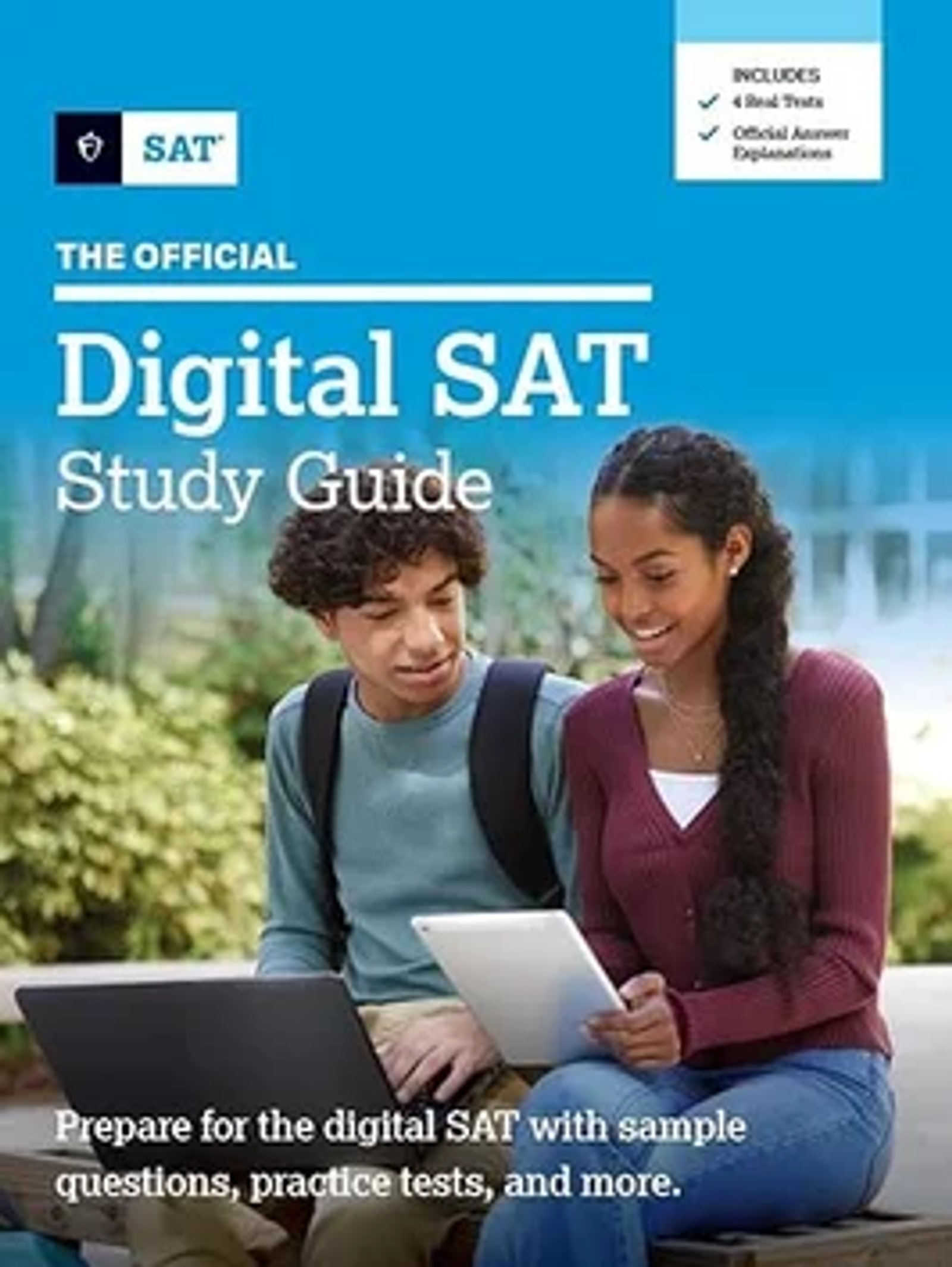
Price: Approximately $35 on Amazon
In previous years, I used to tell students that the College Board’s SAT guide was the essential book they absolutely needed in their study toolkit. Now, my recommendation is quite the opposite: don’t bother buying it! Why? Because nearly all of its content is available for free online.
The four practice tests included in this book can be accessed for free on the digital platform Bluebook. Moreover, since you’ll be taking the new digital SAT on a computer, practicing online helps you get familiar with navigating the testing software.
Does the book offer anything beyond the practice tests? Yes, it has several pages dedicated to explaining the test structure, basic strategies, and answer explanations. However, since most of this information is also available online, I don’t suggest purchasing the official guide unless you prefer having all the material in printed form. As mentioned earlier, because everyone will take the SAT online now, completing your practice tests digitally is the most effective way to prepare for the new digital SAT.
Keep reading for a summary of the advantages and disadvantages of the best SAT prep book for practice questions, as well as the top books for each SAT section.
Best Book for Practice Questions: 7 Full-Length Practice Tests for the Digital SAT
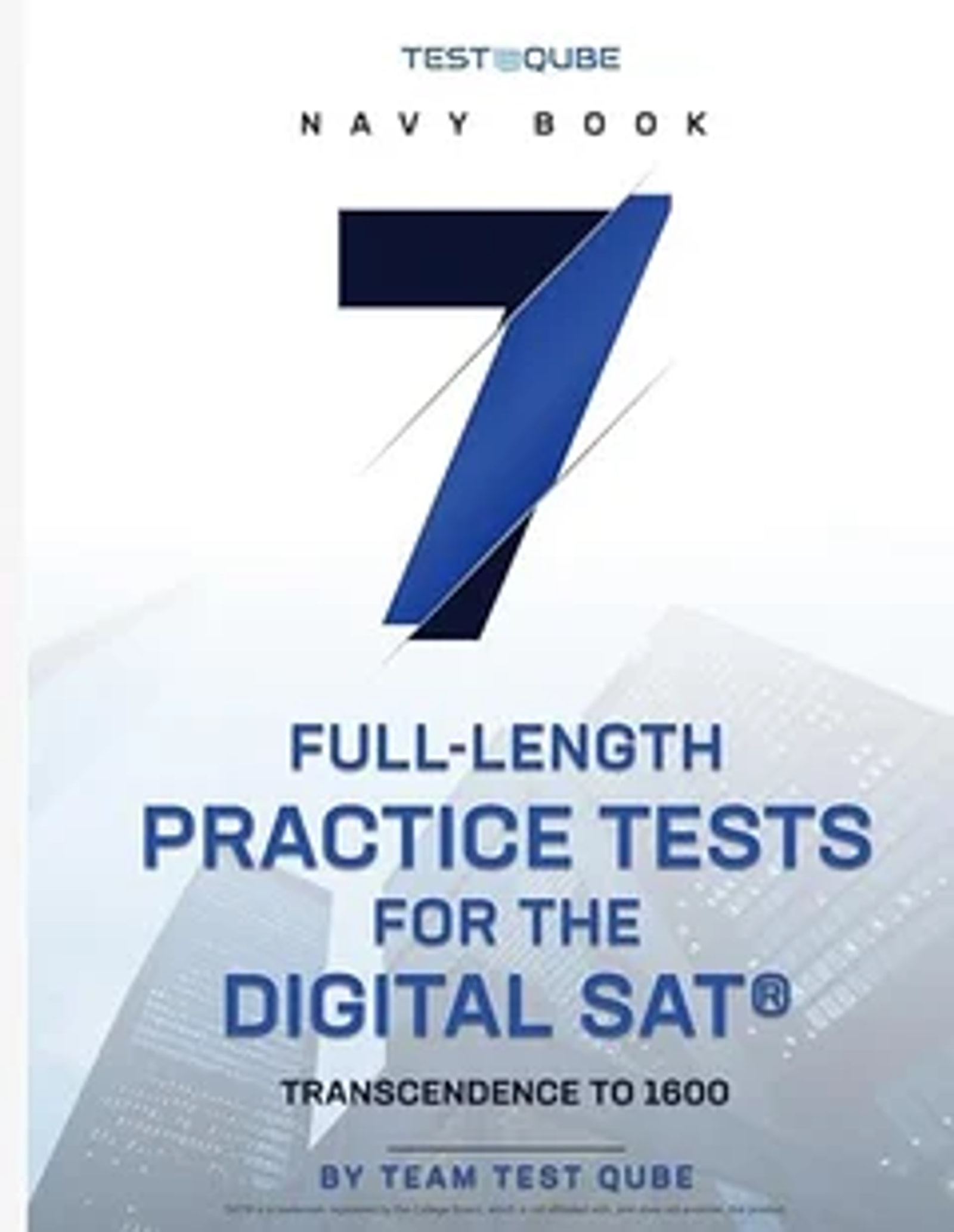
Price: Around $30 on Amazon
Both students and educators have reported that Test Qube’s practice tests closely simulate the real digital SAT — which is no easy feat! This book contains seven full-length practice exams, totaling over 24 hours of practice.
Pros:
The questions are realistically designed and closely mirror official SAT questions. Many students have noted that their scores on Test Qube’s exams were very similar to their actual digital SAT results—something many other prep books fail to achieve.
If you want additional practice tests, especially online versions that closely imitate the digital SAT interface, Test Qube’s website allows you to buy up to seven more full-length tests.
Cons:
Several users have complained that the book’s font is quite small, making it difficult or tiring to read.
This book is relatively expensive, costing over 50onAmazon.AdditionaltestsonTestQube’ssitecostaround30 each. However, the first digital test is free.
In-depth answer explanations are available only on Test Qube’s website—you’ll find only the correct answers in the book itself, with no detailed walkthroughs.
Best Traditional SAT Prep Books for Instruction, Strategy, and Practice Questions
The following three SAT prep books are solid choices, though each has some limitations. These are currently the best options for content review and practice problems. Let’s explore their strengths and weaknesses.
SAT Prep Black Book, 3rd Edition
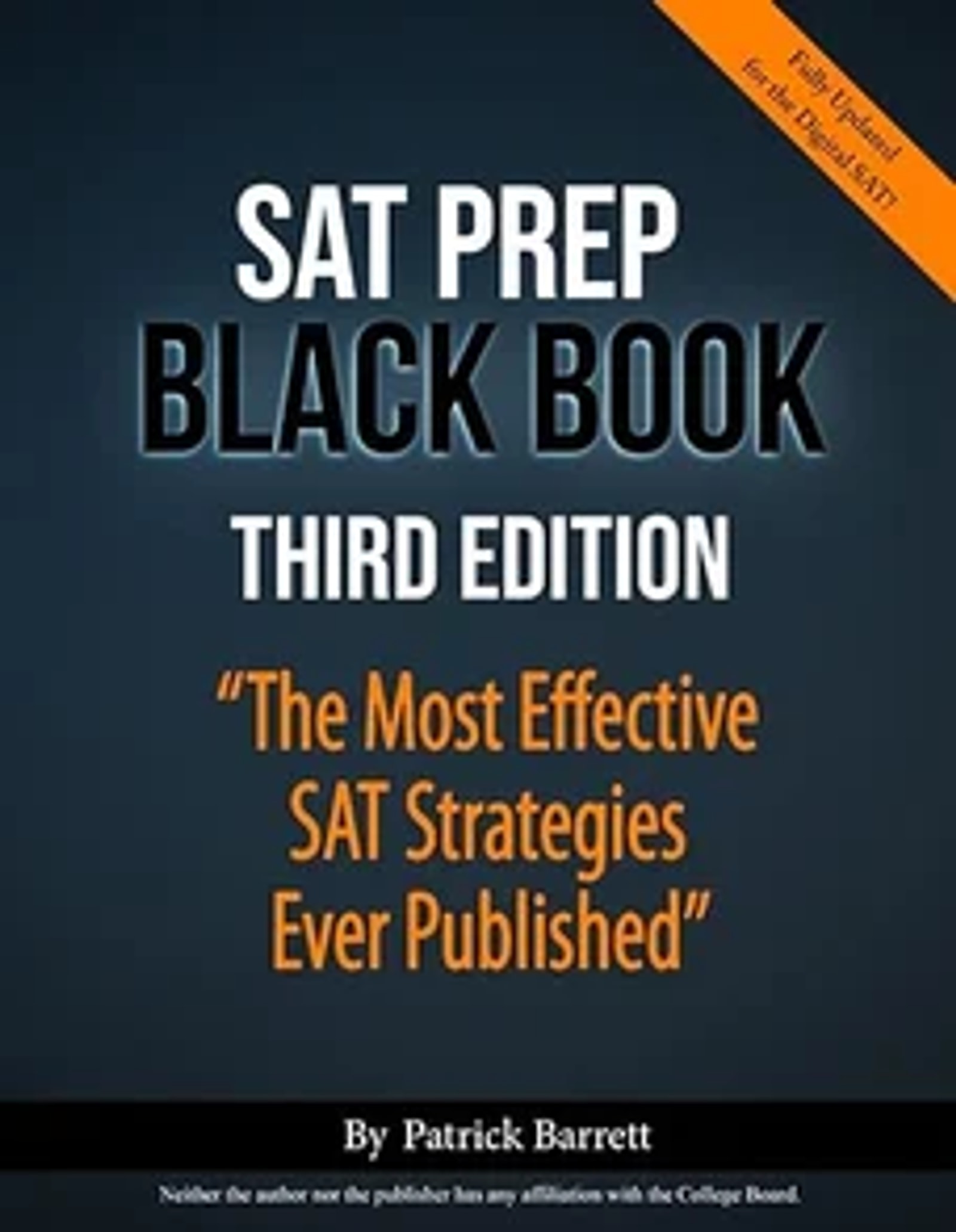
Price: About $32 on Amazon
I strongly recommend the SAT Prep Black Book for its insightful strategies and test-taking advice. Written by Mike Barrett, who has deeply studied the SAT, the book explains different question types and offers key tips, such as identifying tricky wording and misleading “distractor” answers. The latest edition is fully updated for the digital SAT.
Pros:
It’s excellent for students interested in understanding the SAT’s structure, format, and common traps, and who want practical strategies for answering questions efficiently.
Useful for all students regardless of ability level, as Barrett tailors his guidance based on your target score.
Provides detailed answer explanations for every question on the four official digital SAT practice tests. Where the College Board skips steps or fails to clarify why certain answers are wrong, this book thoroughly walks you through each problem.
Helps shift your mindset when taking the SAT by incorporating effective strategies that boost confidence with each question type. However, its focus is on strategy rather than concept review.
Cons:
It contains no original SAT practice questions. It must be used alongside official practice tests since it references and explains official SAT problems in detail.
The book’s emphasis is on strategy and SAT comprehension, not on studying fundamental content. For example, if you need to relearn sentence parallelism or linear functions, you’ll need other resources.
Although I find Barrett’s engaging writing style helpful, this is subjective; some readers may not connect with his explanations or strategies.
Barron's Digital SAT Study Guide 2025
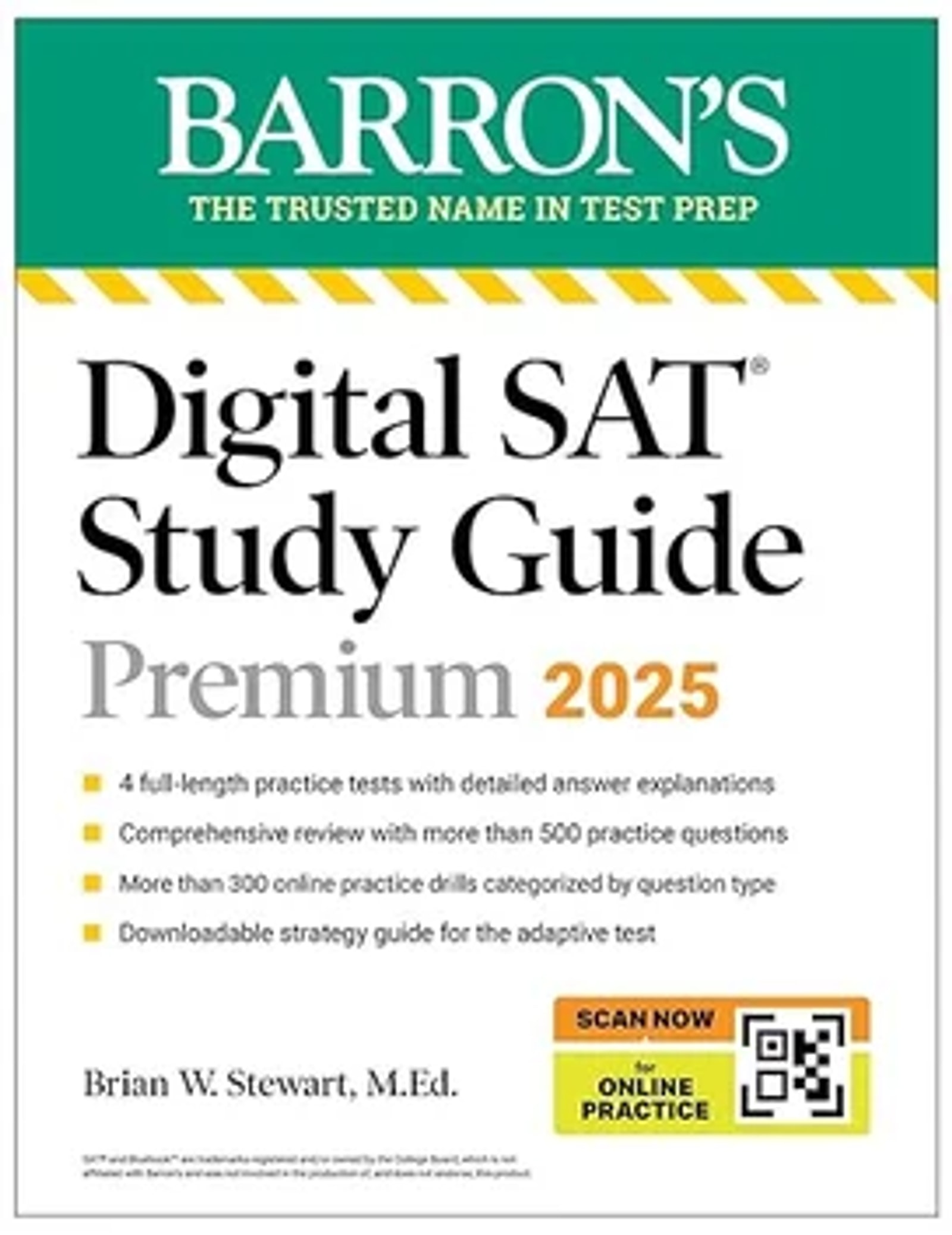
Price: Around $26 on Amazon
Barron's SAT 2025 is another comprehensive prep book that delivers extensive content review, sample questions, and practice tests for the new digital SAT.
The book includes four full-length practice tests and one print adaptive test designed to mimic the digital SAT format, giving you plenty of practice opportunities.
It offers a diagnostic test, which is a useful tool to familiarize yourself with the digital SAT, get into a testing mindset, and identify any weaknesses you need to work on.
Barron's is very thorough, covering most topics critical for the digital SAT. Due to its dense presentation, it tends to be more effective for high-scoring students who can quickly engage with the material and sustain focus. If you’re able to break down and organize the material in manageable portions, this prep book can provide valuable practice.
Cons:
While the print adaptive practice test is helpful, it doesn’t fully substitute for taking an actual digital adaptive test. The real digital SAT is administered on a device like a laptop or tablet, not as a paper booklet. For some students, practicing adaptive testing on paper might be a useful stepping stone before transitioning to the digital format. However, for those aiming to get comfortable with the digital adaptive environment, this book won’t fully replicate that experience.
Some questions in Barron's are a bit unnecessarily complex and confusing. Real SAT questions require deep reasoning but generally use straightforward language. Therefore, the Barron's questions, although helpful, might be harder than necessary and less reflective of the actual test’s style.
Princeton Review Digital SAT Premium Prep, 2025
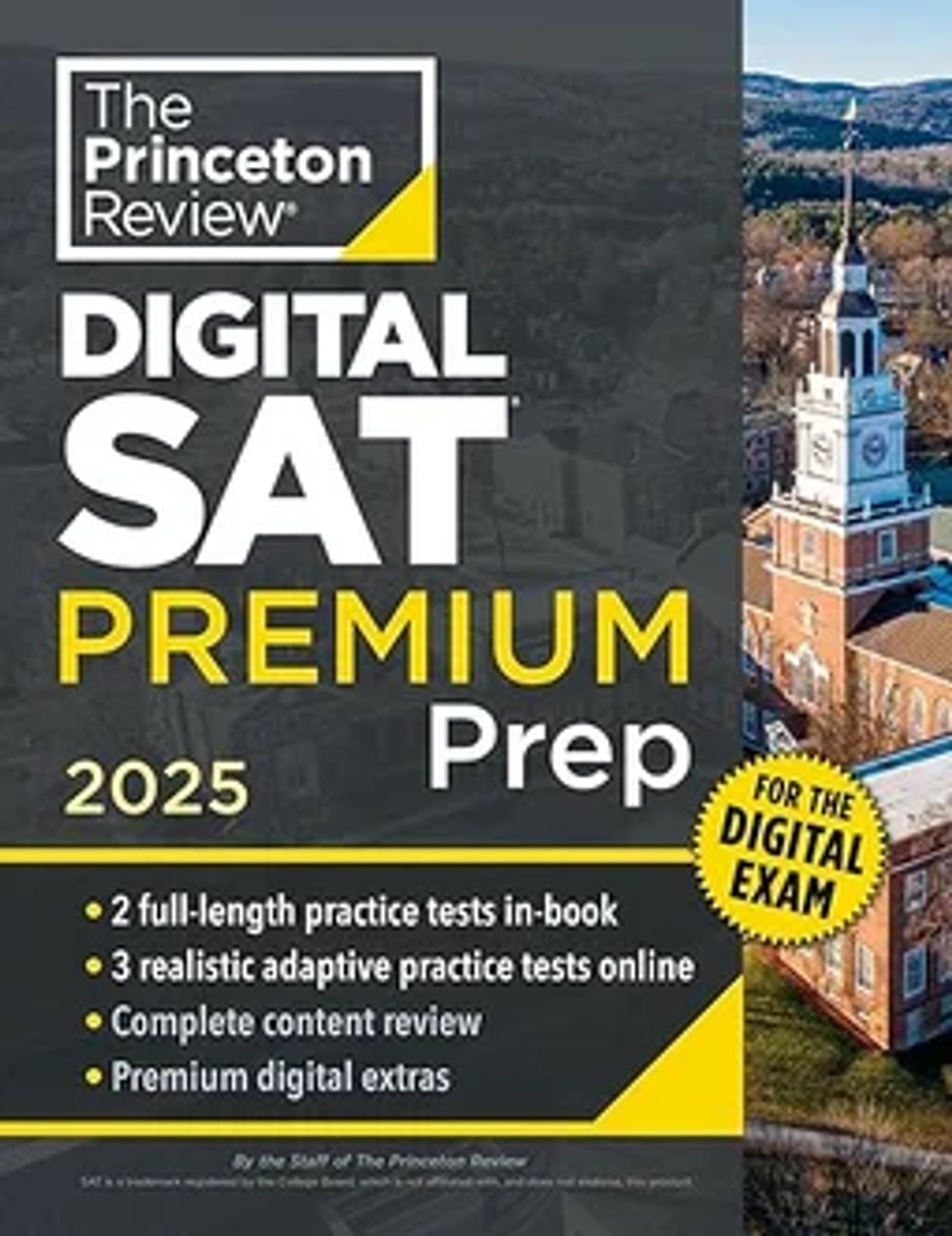
Price: About $25 on Amazon
Like Barron's, The Princeton Review's Digital SAT Premium Prep, 2025 Edition offers a thorough review of the digital SAT, covering essential concepts such as grammar rules and algebraic functions, alongside strategies for tackling questions and managing time.
Pros:
The book includes five full-length practice tests—two are paper-based in the book, and three are online exams—providing realistic digital practice aligned with the all-digital format.
It features detailed answer explanations for practice questions that help you understand how to approach similar problems in the future and during the test.
The online practice tests use adaptive testing, so you become familiar with this assessment style before the real exam.
Cons:
The Princeton Review shares one of Barron's major disadvantages: some questions have overly complicated wording, which does not align well with the straightforward style of official digital SAT questions. While the practice tests are helpful, they are not the best representation of actual SAT questions.
Some content reviews and questions are too simple conceptually. Barron's might better suit motivated students aiming for top scores, while this book is more appropriate for students scoring around or below 600 per test section. Don’t expect it to prepare you to score far beyond that range.
The book doesn't break down content areas into as many subtopics as it could, so some subjects lack detailed coverage.
Its straightforward, traditional prep style may not suit everyone. While some students might prefer this approach, others could find the book boring.
All the SAT prep books mentioned above have their strengths and weaknesses. Together, however, they provide fairly comprehensive preparation across major areas: practice questions, content review, and test strategies.
If you want to focus more deeply on a specific SAT section, subject-specific prep books are likely more beneficial. The following are my top recommendations for SAT Math, Reading, and Writing.
Best Books for SAT Math
Subject-focused SAT prep books often offer more in-depth preparation. They can also be less overwhelming than massive comprehensive guides. If you need extra preparation in one section or want to improve your score step-by-step—taking advantage of colleges’ superscoring policies—these targeted books are excellent resources.
Let’s start with my math prep book recommendations, beginning with Dr. Steve Warner’s 1,000 New SAT Math Problems.
Dr. Steve Warner’s 1,000 New SAT Math Problems
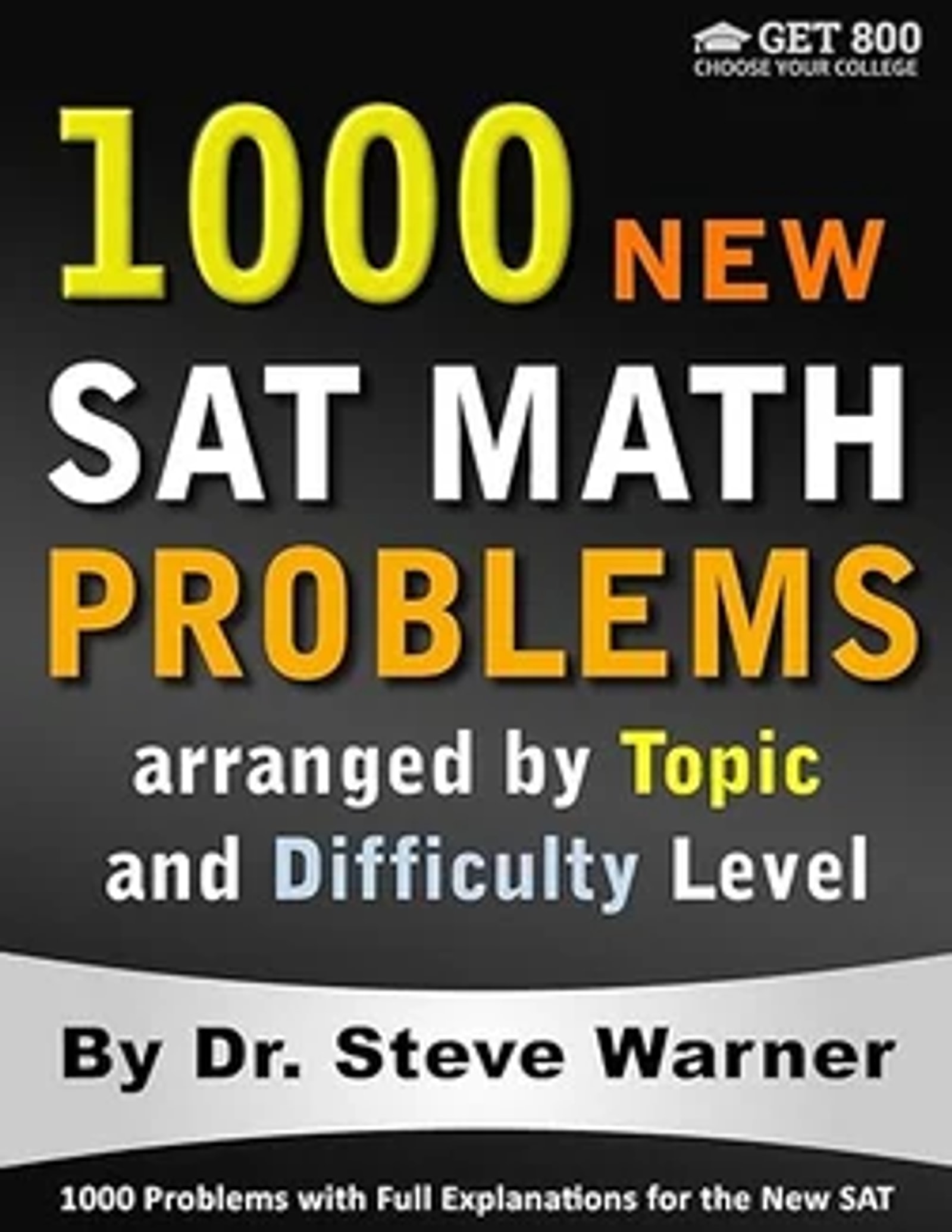
Price: Approximately $65 on Amazon
Dr. Steve Warner’s 1,000 New SAT Math Problems is his latest book designed to prepare students for the Math sections of the new digital SAT.
Pros:
Like his previous works, Dr. Warner provides a thorough and clear review of SAT Math content and instruction.
The book organizes math concepts by difficulty levels, from Level 1 (easiest) to Level 5 (most advanced). This structure integrates problems across different content areas while letting you focus on chapters that suit your skill level. For example, students already scoring in the 700s will benefit most from practicing Level 4 and 5 concepts.
Each lesson is carefully crafted with realistic practice problems that reinforce understanding.
Answer explanations are detailed and cover multiple problem-solving approaches. These multifaceted explanations cater to different learning styles and help you fully grasp your mistakes and learn how to correct them.
Cons:
Compared to his earlier books, which covered the old SAT, this newer edition feels somewhat limited. The book could be improved by breaking each content area into smaller, more specific subtopics.
At $65, it is a significant investment, especially since it focuses only on one SAT subject.
SAT Math Manual and Workbook: For the New SAT
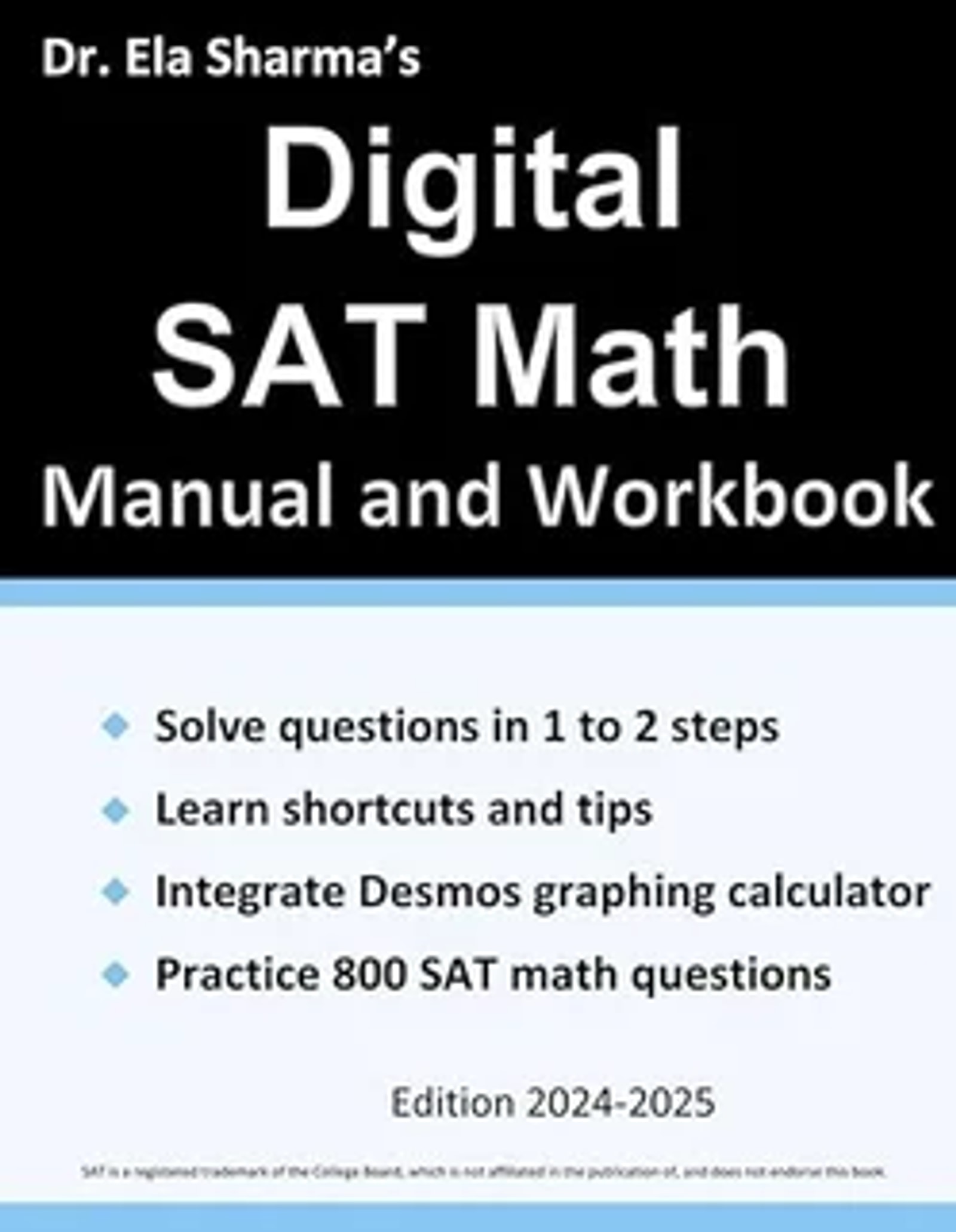
Price: About $37 on Amazon
With over 400 pages, Digital SAT Math Manual and Workbook by Dr. Ela Sharma is a substantial math prep resource worth adding to your SAT study materials. This newer book has strong content and positive reviews on Amazon.
Pros:
Content review and explanations are concise and clear. Students who find long, dense passages overwhelming particularly appreciate the "Key Points" section at the end of each chapter, which summarizes the essential topics.
Practice questions are organized by topic and difficulty, allowing you to customize your math practice based on your needs. The book divides topics into 87 categories so you can target your weakest areas.
It includes a comprehensive section on using the Desmos graphing calculator: a newer technology that can intimidate students. This section explains when and how to use Desmos, helping you feel confident on test day.
Cons:
Priced at $37, it is somewhat expensive for a book covering only the math portion of the SAT. However, if you have Kindle Unlimited, you can access it for free.
It lacks extensive test-taking strategies like time management. Although the book provides plenty of practice problems suitable for all skill levels, it offers less detailed content review if that’s what you need.
PWN The SAT: Math Guide, 6th Edition
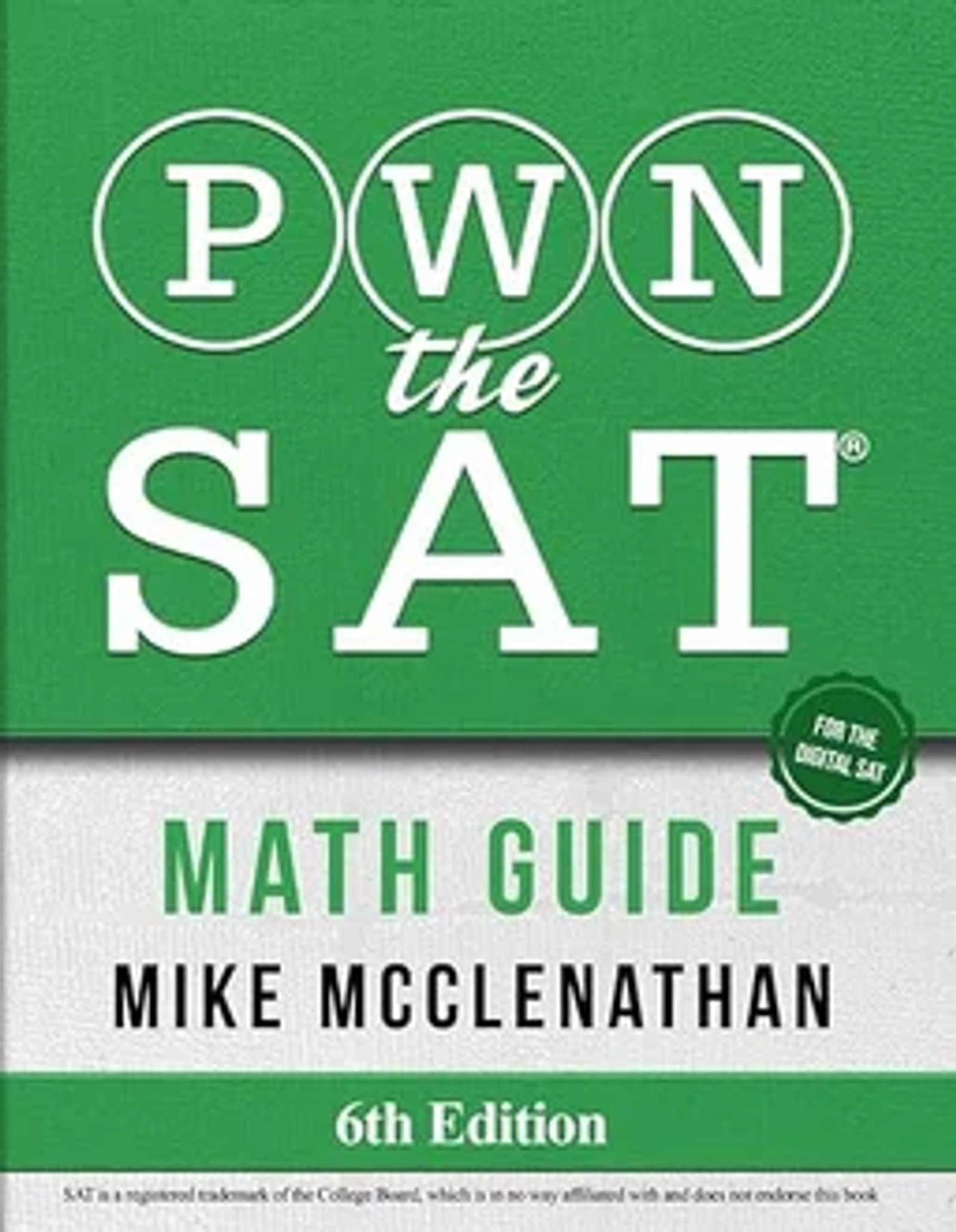
Price: About $32 on Amazon
PWN The SAT: Math Guide targets highly motivated students aiming for top SAT Math scores. Updated for the digital SAT, it breaks down each math section into fundamental concepts to teach you the core material tested on the exam.
Pros:
The book is written in a lively and irreverent style that helps keep students engaged.
It includes realistic practice problems to prepare you for every question type you'll encounter. Each chapter also lists official SAT questions of the same type, allowing focused skill drilling.
By registering on the PWN SAT website, you gain access to bonus materials and video explanations that guide you through practice problems step-by-step.
Cons:
Its audience is somewhat limited. While the book supports high scorers with strong math skills, it’s less accessible for students struggling to build foundational math knowledge. If you need to strengthen basic math concepts, PWN the SAT might not be the best choice.
While several authors offer excellent resources to boost your SAT Math score, I have just one recommendation for SAT Reading and Writing prep: Erica Meltzer.
Best Books for SAT Reading and Writing
If you want to improve your reading comprehension or grammar skills for the digital SAT’s Reading and Writing section, I highly recommend Erica Meltzer’s books.
The Critical Reader: The Complete Guide to SAT Reading, 5th Edition
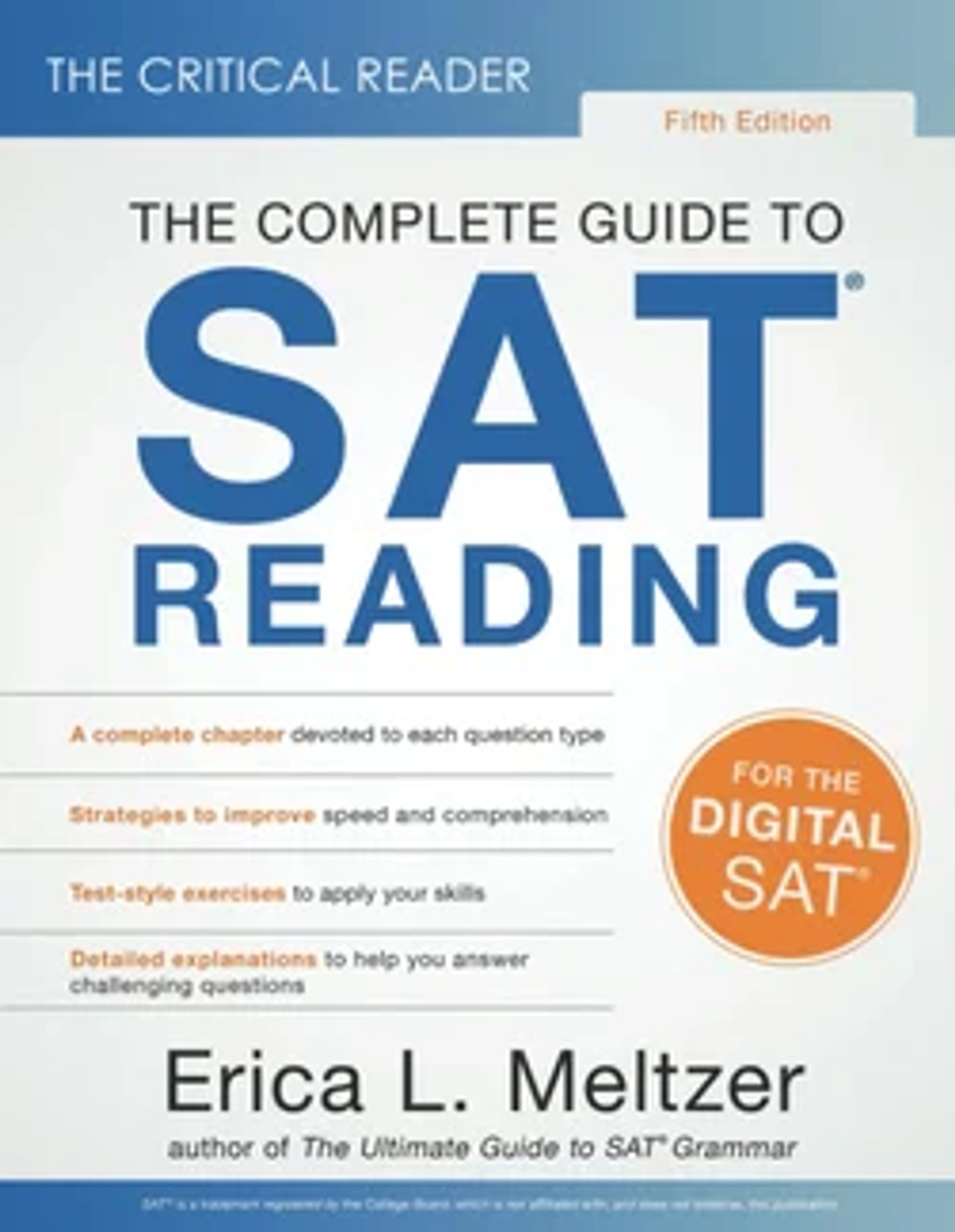
Price: About $32 on Amazon
Though SAT Reading may seem difficult to break down, Erica Meltzer’s Complete Guide to SAT Reading does an excellent job outlining the key skills you’ll need for this section.
Pros:
It offers practical strategies for answering questions. Unlike English classes, where interpretations can be subjective, the SAT Reading section requires finding the single correct answer with no ambiguity. This book helps you zero in on that answer.
In addition to time management and reading techniques, it teaches you how to quickly locate and identify important information. It also provides useful approaches for paired supporting evidence and data interpretation questions, many of which involve reading tables or graphs.
The book includes a helpful list of common multiple-meaning words with their various definitions, along with strategies for using context clues to determine meanings.
Cons:
Some students dislike the book’s layout and formatting, finding the font small and crowded and the design lacking creativity or engagement.
The writing style is straightforward and to the point. While some appreciate this directness, others find it dry. You can get a sense of Meltzer’s tone on her blog, The Critical Reader, to see if it suits your style.
The book focuses heavily on content explanations and includes fewer practice questions, so you’ll likely need supplemental materials for ample practice.
The Critical Reader: The Ultimate Guide to SAT Grammar, 6th Edition
Price: About $31 on Amazon
Erica Meltzer’s Ultimate Guide to SAT Grammar clearly explains the grammar rules important for the SAT Reading and Writing section. It does a great job familiarizing you with the types of grammar questions you will encounter on test day.
Pros:
The grammar questions are realistic and cover the rules tested on the digital SAT.
The book breaks down essential grammar skills so you can study them individually. Instead of guessing answers that just “sound right,” you’ll learn the rules you absolutely need to know.
Cons:
Grammar now plays a smaller role on the digital SAT, with only 12–15 questions focused on grammar. For many students, $31 might be a high price for a book covering only a small portion of the exam.
The writing style is similar to Meltzer’s Reading book and may feel dry to some students.
This concludes our list of the best SAT prep books. Since this guide is designed to help you streamline your studying, let’s discuss how you can effectively use these books to reach your target scores.
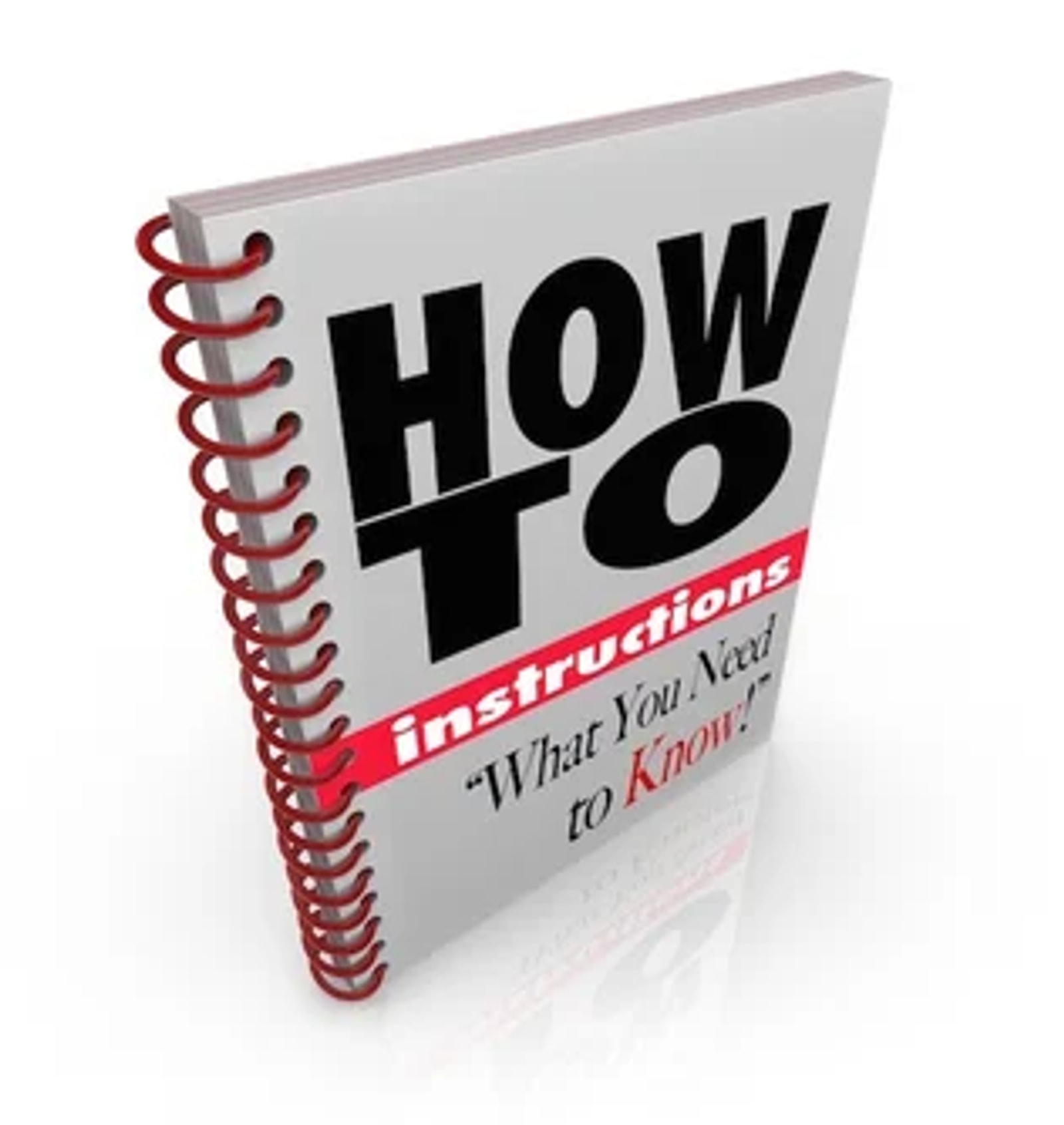
Key Tips for Studying With SAT Prep Books
There are many SAT prep books available. Instead of reading them cover to cover, it’s better to create a study plan and break each book into manageable goals.
Begin by taking an official College Board practice test as a pre-test to establish your baseline score. Use the answer key to score yourself and analyze your results to identify which areas need your focus.
Save one of the official practice tests for right before the real SAT to measure how much you’ve improved. Along the way, other practice tests can serve as benchmarks to track progress and adjust your plan if needed.
A comprehensive prep book like Test Qube’s or Barron’s can be used alongside subject-specific guides, such as Dr. Steve Warner’s Math book or Erica Meltzer’s Reading and Grammar books. Based on your goals and needs, decide how much time to devote to each section to maximize your study effectiveness.
You have plenty of room to customize your plan based on your strengths, weaknesses, and objectives. This requires solid planning and self-discipline, as well as reflecting on what methods help you stay interested, retain information, and stay organized.
If planning this much feels overwhelming, you might also consider SAT prep options beyond using a book list.
Final Tip: Explore Your SAT Prep Options
The SAT is a unique exam. Success in math and English classes doesn’t automatically translate to a high SAT score. Prep plays a crucial role for most students, which the College Board now recognizes by offering free online practice materials.
Since your time is limited, you want to make your prep as efficient as possible. If you dedicate time to studying, you should see results.
While the recommended digital SAT books are valuable tools, they can sometimes feel overwhelming, repetitive, or expensive.
Take time to explore different options, and learn about the SAT through high-quality online resources and detailed guides like this one. If you’re putting effort into your prep, ensure you’re seeing progress and also enjoying the process along the way!
Related Posts
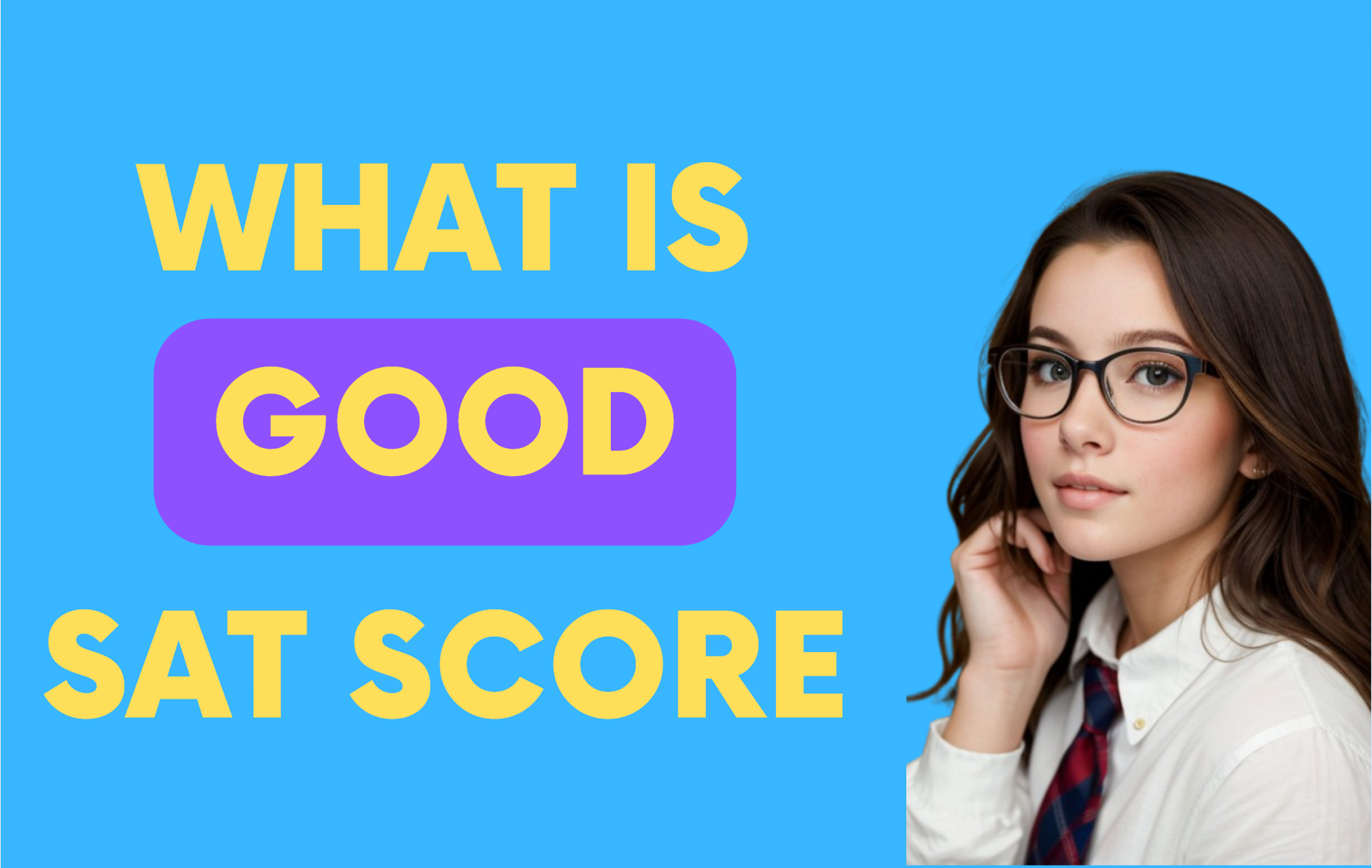
Learn what makes a great SAT score, how to set your goal, and boost your chances of getting into dream colleges with strategic planning!
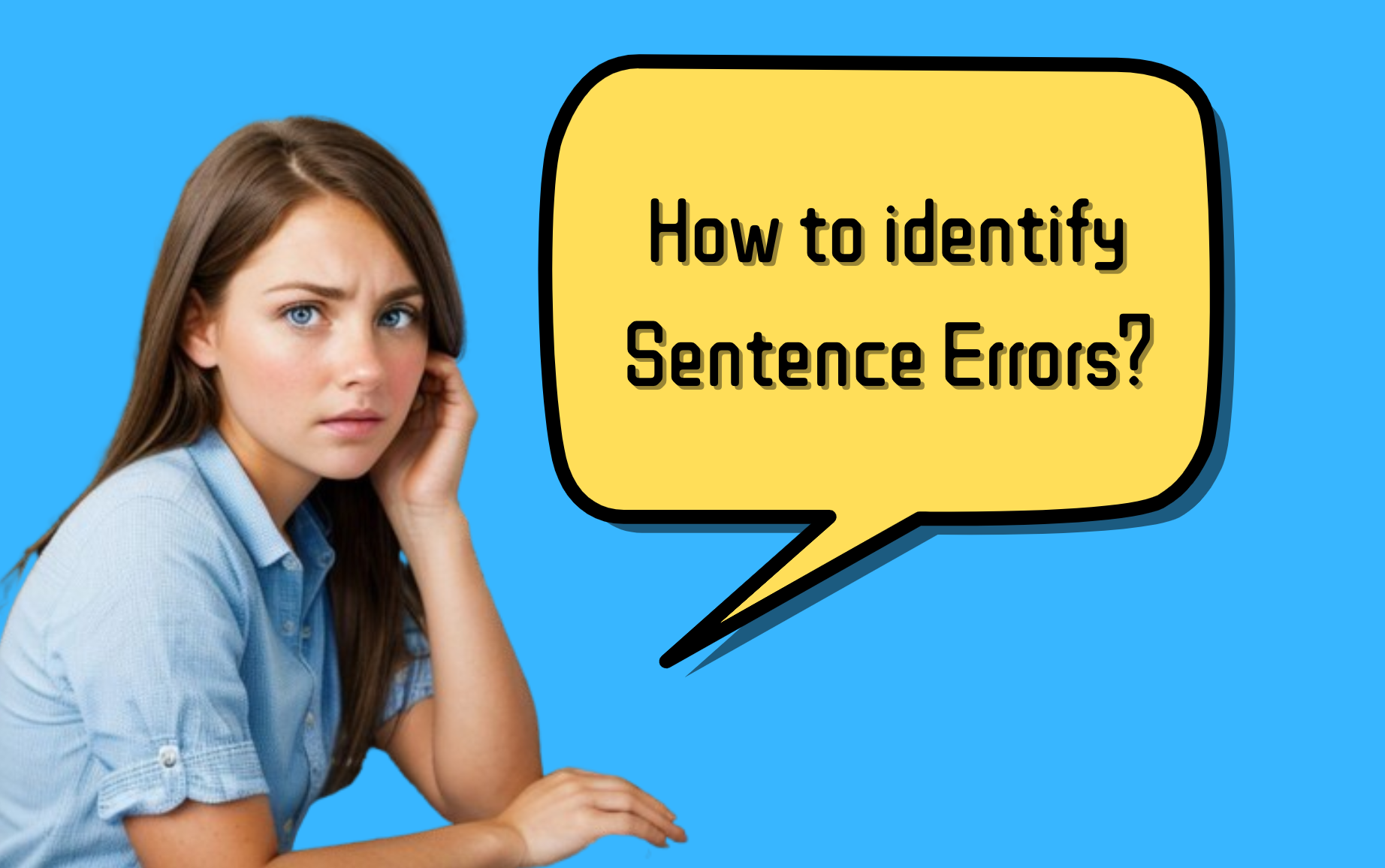
Boost your SAT Writing score! Explore essential tips, avoid common mistakes, and sharpen your grammar and error-spotting skills.